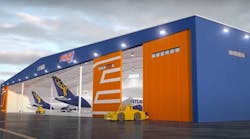Human factors in aircraft maintenance has been recognized as a must in aerospace today. The industry has embraced the importance of this training, governments have given due recognition through regulation. After initial awareness training, organizations have been able to follow up with recurrent training, enhancing the long-term sustainability of their programs. Such programs should be monitored and measured in order to develop relevant and productive recurrent training programs. We cannot afford to waste our technician’s time and bore them with irrelevant information. The information presented during human factors training must be precise, relevant, and applicable.
Key Elements for a Successful Human Factors Program
Our experience has shown that an organization’s maintenance human factors program should have the following attributes:
1. Have 100 percent support and participation from
management and
maintenance personnel.
2. Become part of the culture and work ethic.
3. Focus on improving
communication skills.
4. Be tailored to the work environment, including identification and correction of potential contributing factors.
5. Include behavioral analysis for those attendees participating in the program.
6. Incorporate a team approach.
7. Evaluate errors and incidents for further training topics through the
collection of data.
Managing for Success
A successful human factors program requires senior management participation, support, and monitoring. It is a continuous program that requires a champion, such as the Quality Assurance Department, to ensure that it remains effective. Human factors training for managers and technicians and recurrent training initiatives are all ongoing efforts which guarantee that a human factors training program remains relevant and targeted to maintenance technicians.
Management must be aware of the paradigm shift in the minds of technicians who have participated in human factors training so they can facilitate change within the organization. Without management’s full support and participation, an organization will not benefit from the time and money invested in such training. Both groups need to be involved in order for synchronization of language and concepts taught in the program.
Changing Attitudes
The cultural change initiated during a human factors program will produce excellent results when everyone within the organization embraces the same thought process. After all, we want to improve professionalism in our industry and ultimately reduce incidents. You will not see an immediate return on investment or dramatic overnight changes. We are dealing with changing attitudes and behaviors in people, which are the most difficult attributes to change. But, with perseverance, and as more people complete the program they begin to speak a common language. Soon, you will start to see a behavioral change within the organization that will provide long-term and lasting benefits.
Participation Required
Along with endorsing the training, senior managers should also participate in the classes and take the message to heart. Senior management needs to go through the training, support it, by modeling the behavior taught in the class in their own working environment. If senior management does not model the behaviors that are taught in the class, the change in attitude and culture will not carry throughout the organization. But, with the active participation of management and the technician work force, benefits of human factors training will start to be realized, including a reduction of incidents that could have been the start of the chain of events leading to an error or worse.
New Tools for Technicians
An overall increased awareness of the importance of the safety nets technicians can personally use to reduce maintenance error is perhaps the largest benefit they acquire from human factors training. This translates into a work force with a much sharper focus on preventing errors which could lead to a significant incident or even catastrophic events. In general, human factors training can lead to improved quality, a safer environment, and a more involved and responsible work force. More specifically, the reduction of even minor errors can provide measurable benefits including cost reductions, fewer missed deadlines, reduction in work related injuries, reduction of warranty claims and reduction in more significant events which can be traced back to maintenance error.


